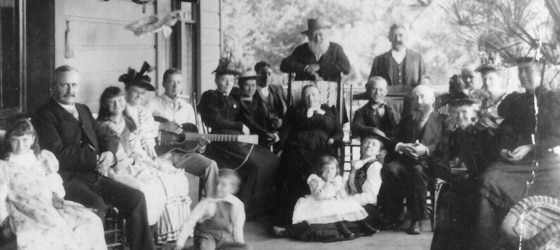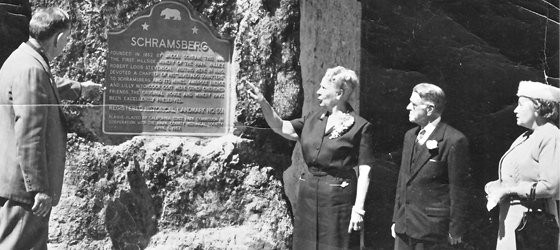Tidings, Wine and Viticulture
Schramsberg – History You Can Take Home in a Bottle
This is an excerpt of an article written by Tom Spaulding, a local photographer and historian. It was first published in the Vol. 22, No. 2 edition of Tidings, our quarterly newsletter. To get your copy of Tidings, become a member today!
Discover what we have on Schramsberg in our Research Library, and learn more about Robert Louis Stevenson’s time in Calistoga.

For anyone interested in the history of Napa wineries, Schramsberg Winery has it all. Only Charles Krug Winery, and possibly David Fulton Winery, can lay claim to being older. There are well-preserved 19th century buildings and extensive 19th century tunnels that still show the marks made by the pick-axes of the Chinese laborers who dug them. And Schramsberg has a real pedigree for premium, artisanal winemaking, both in its historic past under Jacob Schram and in its rebirth in the latter part of the 20th century under Jack Davies.
In his obituary from 1905, the St. Helena Star laid out the essential details of the life of the founder of Schramsberg, Jacob Schram. On May 26, 1826, Jacob Schram was born in Pfeddersheim, a town in the grape-growing region of southwest Germany that was already more than a thousand years old. In the early 1840s he immigrated to New York and worked there as a barber until 1853…Upon giving that up, he journeyed to Napa County, first to the resort of White Sulphur Springs west of St. Helena, where he worked as a barber and ladies’ hairdresser before a fire “burned him out of house and home.” He then retreated for a time to Napa to ply his trade as a barber. Having traveled more than 5,000 miles from his home, Schram found and married Annie Christine Weber, born in Hochheim, Germany. On August 12, 1862, Jacob returned to the St. Helena area with Annie to clear land to plant grapevines and establish the foundations of a house…
In the summer of 1880, Stevenson and his new bride Fanny stayed in Calistoga, the account of which was published in Silverado Squatters in 1883. Stevenson was not impressed by all the Napa wines he tried. The oft-used quotation from him that appear in two signs along Highway 29, “and the wine is bottled poetry,” does not actually describe the wine he tasted. He instead said that “Wine in California is still in the experimental stage,” and those pockets of land that will someday grow the grapes from which one will be able to say, “and the wine is bottled poetry: these still lie undiscovered…Meanwhile, the wine is merely a good wine.” And yet he was impressed by Schram’s wines, as was the rest of the public. In 1881 the St. Helena Star reports Schram shipping his wine to the east coast in 1876 and to Europe by 1880. They went so far as to say that his wine “has probably the highest reputation of any American wine.”
Jacob and Annie Schram had two children. The first, Amelia, died as a child, probably not long after she was recorded as 6-months-old by the census taker in July 1860. The second, Herman Adolph, born April 23, 1861, lived with them to the end of their lives and is listed alongside his father in records of the time as one of the winemakers of the area…Herman and his wife Anna had two sons, Jacob Herman “Jack” Schram and Robert Sherwood Schram. Herman’s mother Annie died in 1901 and his father Jacob died in 1905. Herman and his family continued to live in the family home and run the winery for another seven years. At the end of 1912 they sold the estate and moved briefly to San Francisco and then Burlingame, where Herman worked as a salesman. All of the family stayed in Northern California, and eventually all of them, except Jack, were returned for burial at St. Helena Cemetery – Herman in 1951, Anna in 1965, Robert in 1971, and Emma in 2003. Jack died in 1936 as a resident of Grass Valley.
Over the next 8 years, the property changed hands several times. Whether any of the purchasers had any plans for the property, or whether it was a speculative investment is not clear. The Naylors were the first family after the Schrams to keep it for any period of time…What brought Raymond and Sarah and their seven children to California from Salt Lake City remains a mystery…After the Naylors moved to San Mateo, Raymond was listed in the 1940 census as a vineyard owner. In 1941, the Naylors sold Schramsberg to John Gargano but as it turns out, that was not the end of the family’s presence in the Napa Valley. Captain Naylor’s daughter Elizabeth married John Daniel, the heir to the Inglenook Winery, and settled in Rutherford…

Jack and Jamie Davies formed the Schramsberg Vineyards Company and purchased the property from Katharine Cebrian on July 29, 1965. At that time, it was one of only 24 legally bonded wineries operating in Napa County – today there are nearly 600. Jack Davies had extensive business experience, but not in the world of winemaking. He had been an executive with Ducommon, Inc., Fibreboard Corporation, Kaiser Aluminum & Chemical Corporation, McKinsey and Company, and The Rod McClellan Company.
Inspired by the wines of Martin Ray at Mount Eden Vineyards, the Davies made the decision to specialize in sparkling wine…The American market then was dominated by cheaper producers from the Midwest and New York state who did not use méthode champenoise of secondary fermentation in the bottle. In Napa, the only existing winery that specialized in sparkling wine was Hanns Kornell Cellars. The only other major premium sparkling wine producer in the area was Korbell in Sonoma County’s Russian River Valley…On April 28, 1972, the revived Schramsberg Winery got a big boost of publicity when the Nixon administration served Schramsberg sparkling wine – the 1969 Blanc de Blancs – at a state dinner titled “Toast to Peace” in Beijing, China. Schramsberg wines have been served at White House dinners for every administration since then…
Come July 29 of this year, the Davies family will have run the historic winery for half a century (1965-2015), which is just how long the founding family, the Schrams, ran it: 1862-1912. It’s rare for any winery in the Napa Valley to have been in the hands of one family for 50 years, but it will have happened twice for Schramsberg. Such a rich history is reason enough to make a visit, but you don’t have to be a history buff to enjoy yourself there. If the cave tours don’t do it for you, then surely a taste of America’s finest sparkling wine will.

